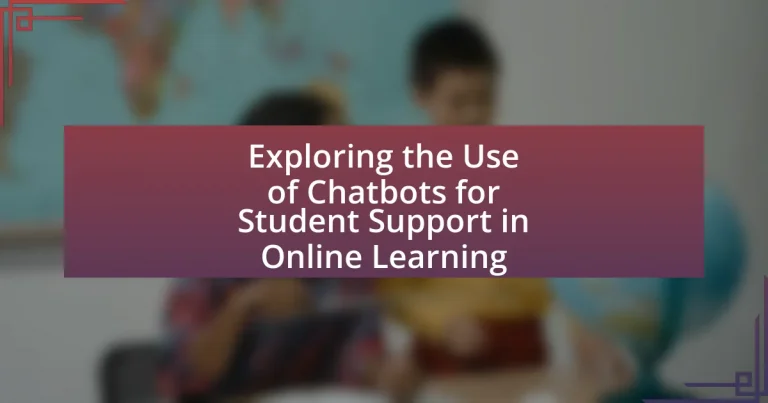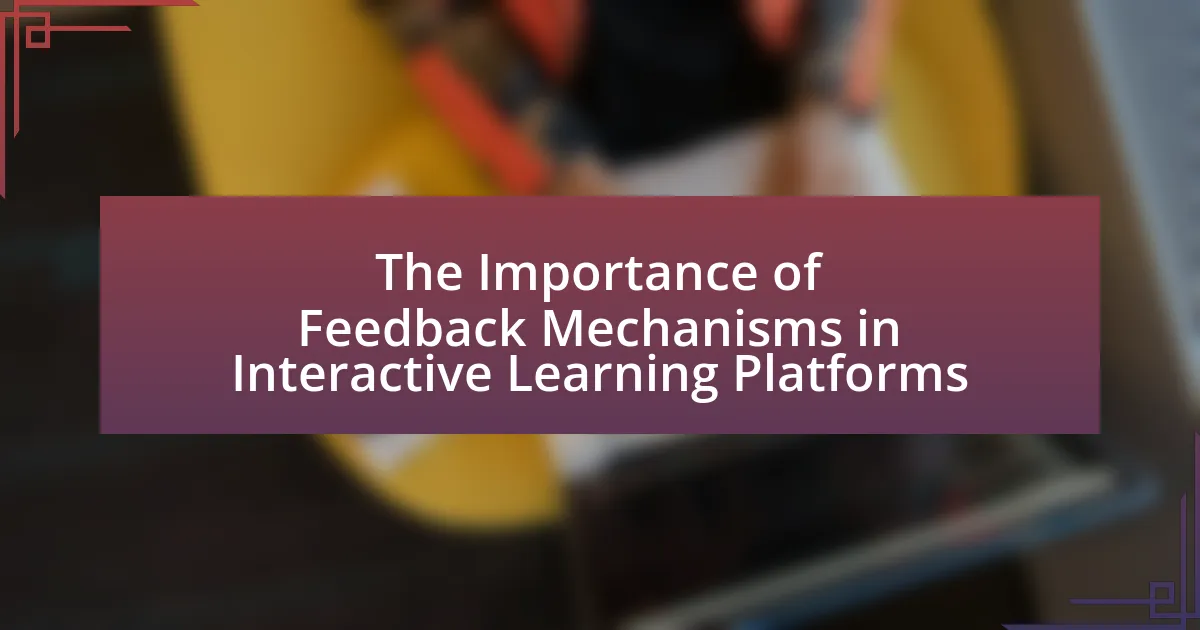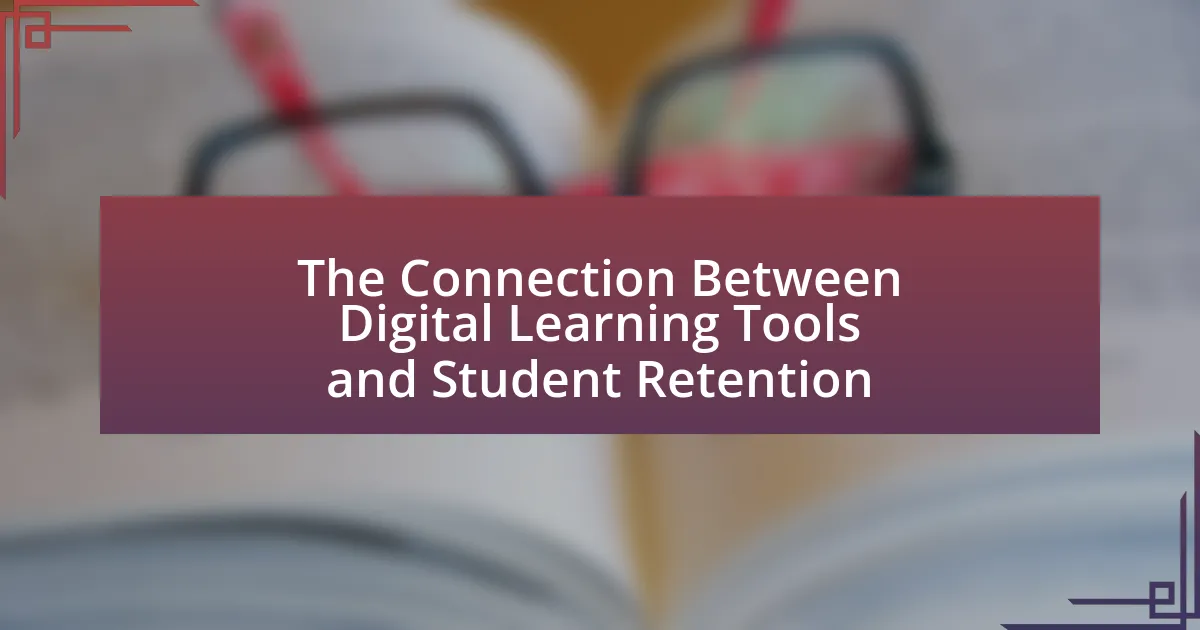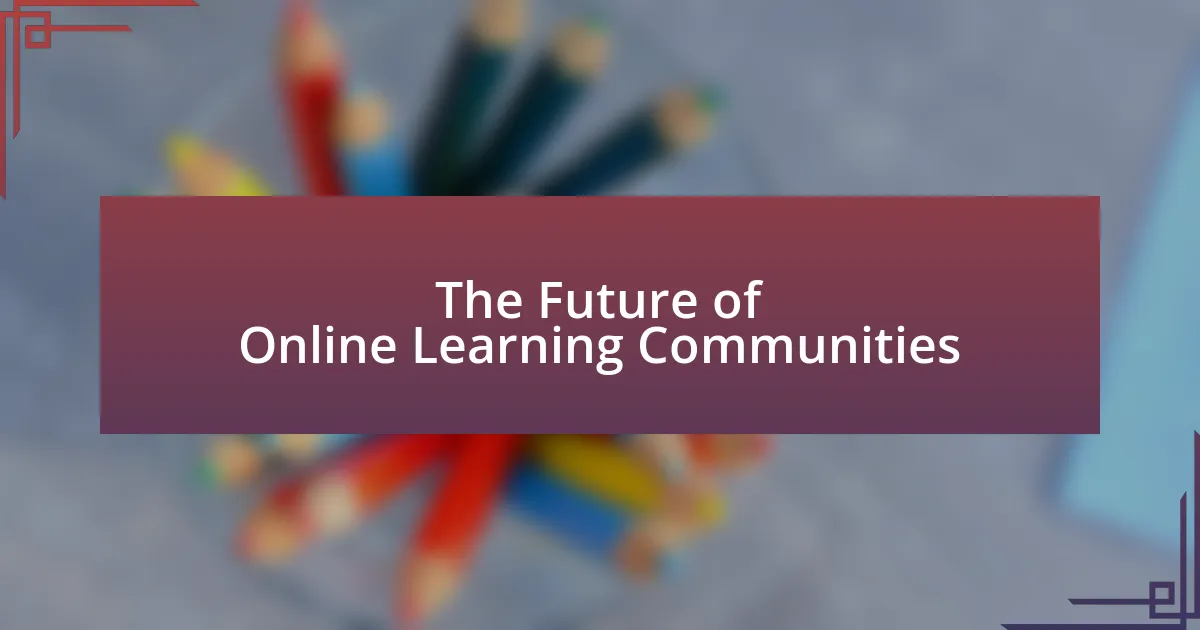Chatbots are artificial intelligence tools increasingly utilized in online learning environments to enhance student support. They provide instant responses to inquiries, facilitate access to educational resources, and offer personalized learning experiences, thereby improving student engagement and satisfaction. The article explores the functionality of chatbots in academic and administrative support, the technologies that underpin their operation, and the benefits they offer, such as 24/7 availability and tailored assistance. Additionally, it addresses the challenges and limitations faced by chatbots, including their ability to understand complex queries and maintain user privacy, while also discussing future trends and innovations in chatbot technology for education.

What are Chatbots and Their Role in Online Learning?
Chatbots are artificial intelligence programs designed to simulate conversation with users, often utilized in online learning environments to enhance student support. Their role in online learning includes providing instant responses to student inquiries, facilitating access to educational resources, and offering personalized learning experiences. Research indicates that chatbots can improve student engagement and satisfaction by delivering timely assistance and reducing the cognitive load on educators. For instance, a study published in the Journal of Educational Technology & Society found that chatbots significantly increased student interaction and retention rates in online courses.
How do chatbots function in the context of student support?
Chatbots function in the context of student support by providing instant, automated responses to student inquiries, thereby enhancing accessibility and efficiency in communication. These AI-driven tools can answer frequently asked questions, assist with administrative tasks, and guide students through academic resources, which reduces the workload on human support staff. For instance, a study by the University of California found that chatbots can handle up to 80% of routine inquiries, allowing human advisors to focus on more complex issues. This capability not only improves response times but also increases student satisfaction by providing 24/7 support.
What technologies underpin chatbot functionality?
Chatbot functionality is primarily underpinned by natural language processing (NLP), machine learning (ML), and artificial intelligence (AI). NLP enables chatbots to understand and interpret human language, allowing for effective communication. Machine learning algorithms help chatbots learn from interactions and improve their responses over time. Artificial intelligence provides the overall framework for decision-making and context understanding, enhancing the chatbot’s ability to engage users meaningfully. These technologies collectively facilitate the development of sophisticated chatbots capable of providing support in various applications, including online learning environments.
How do chatbots interact with students in online learning environments?
Chatbots interact with students in online learning environments by providing instant responses to queries, facilitating personalized learning experiences, and offering administrative support. These AI-driven tools can answer frequently asked questions, guide students through course materials, and assist with scheduling or technical issues. Research indicates that chatbots can enhance student engagement and satisfaction; for instance, a study published in the Journal of Educational Technology & Society found that 70% of students preferred using chatbots for immediate assistance over traditional methods. This interaction not only streamlines communication but also allows educators to focus on more complex student needs, thereby improving overall learning outcomes.
What types of student support can chatbots provide?
Chatbots can provide various types of student support, including academic assistance, administrative help, and emotional support. Academic assistance involves answering questions related to course content, providing study resources, and offering tutoring services. Administrative help includes guiding students through enrollment processes, providing information on deadlines, and assisting with financial aid inquiries. Emotional support encompasses offering mental health resources, facilitating peer connections, and providing a platform for students to express concerns. These functionalities enhance the overall learning experience by making support readily accessible and timely, which is crucial in online learning environments.
How do chatbots assist with academic inquiries?
Chatbots assist with academic inquiries by providing instant access to information and resources, enabling students to receive timely support. They can answer frequently asked questions about course materials, deadlines, and institutional policies, which enhances the learning experience. For instance, a study by the University of Southern California found that chatbots can reduce response times for student inquiries from hours to seconds, significantly improving student satisfaction and engagement.
What role do chatbots play in administrative support?
Chatbots play a crucial role in administrative support by automating routine tasks and providing instant responses to inquiries. They enhance efficiency by handling administrative functions such as scheduling, answering frequently asked questions, and managing student records, which reduces the workload on human staff. For instance, a study by the University of Southern California found that chatbots can handle up to 80% of common administrative queries, allowing staff to focus on more complex issues. This automation not only streamlines operations but also improves response times, leading to higher satisfaction among students and staff alike.
Why are chatbots becoming essential in online education?
Chatbots are becoming essential in online education because they provide immediate, 24/7 support to students, enhancing their learning experience. This constant availability allows students to receive instant answers to their queries, which can improve engagement and reduce frustration. According to a study by the University of California, 70% of students reported that chatbots helped them feel more connected to their courses and instructors. Additionally, chatbots can handle repetitive administrative tasks, freeing up educators to focus on more complex student needs, thereby increasing overall efficiency in online learning environments.
What challenges do students face in online learning that chatbots can address?
Students face several challenges in online learning that chatbots can effectively address, including lack of immediate support, difficulty in accessing resources, and feelings of isolation. Chatbots provide instant responses to student inquiries, ensuring that learners receive timely assistance, which is crucial for maintaining engagement and motivation. Additionally, chatbots can guide students in navigating online platforms and accessing educational materials, thereby reducing frustration associated with technology use. Research indicates that 70% of students report feeling isolated in online courses, and chatbots can help mitigate this by facilitating communication and providing a sense of connection through interactive support.
How do chatbots enhance the overall learning experience?
Chatbots enhance the overall learning experience by providing immediate, personalized support to students. They facilitate 24/7 access to information, enabling learners to ask questions and receive instant responses, which can significantly reduce frustration and improve engagement. Research indicates that students using chatbots report higher satisfaction levels due to the instant feedback and assistance they receive, leading to improved academic performance. For instance, a study published in the Journal of Educational Technology & Society found that chatbots can increase student interaction and motivation, ultimately fostering a more effective learning environment.

What are the Benefits of Using Chatbots for Student Support?
Chatbots provide several benefits for student support, including 24/7 availability, instant responses, and personalized assistance. Their round-the-clock availability ensures that students can access help at any time, which is particularly valuable in online learning environments where traditional support hours may not align with students’ schedules. Instant responses reduce wait times, allowing students to receive immediate answers to their queries, which enhances their learning experience. Additionally, chatbots can offer personalized assistance by utilizing data to tailor responses based on individual student needs and preferences, thereby improving engagement and satisfaction. Studies have shown that institutions implementing chatbots have reported increased student retention rates and improved academic performance, highlighting their effectiveness in supporting students.
How do chatbots improve accessibility for students?
Chatbots improve accessibility for students by providing instant, 24/7 support and personalized learning experiences. These AI-driven tools can answer questions, guide users through resources, and assist with administrative tasks, thereby reducing barriers to information access. For instance, a study by the University of Southern California found that chatbots can enhance engagement and learning outcomes by offering tailored assistance based on individual student needs. This capability allows students with varying levels of ability and learning styles to receive the support they require, making educational resources more inclusive and readily available.
What features make chatbots user-friendly for diverse student populations?
User-friendly chatbots for diverse student populations incorporate features such as multilingual support, personalized interactions, and accessibility options. Multilingual support allows students from various linguistic backgrounds to engage with the chatbot in their preferred language, enhancing comprehension and comfort. Personalized interactions, driven by AI algorithms, enable chatbots to tailor responses based on individual student needs and learning styles, fostering a more engaging experience. Accessibility options, including text-to-speech and visual aids, ensure that students with disabilities can effectively utilize the chatbot, promoting inclusivity. These features collectively enhance the usability of chatbots, making them effective tools for supporting diverse student populations in online learning environments.
How do chatbots provide 24/7 support to students?
Chatbots provide 24/7 support to students by utilizing artificial intelligence to deliver instant responses to inquiries at any time. These automated systems can handle a wide range of questions, from administrative issues to academic support, ensuring that students receive assistance whenever they need it. For instance, a study by the University of California found that chatbots can reduce response times to student queries from hours to seconds, significantly enhancing the accessibility of information. This capability allows students to engage with educational resources and receive guidance outside of traditional office hours, thereby improving their overall learning experience.
What impact do chatbots have on student engagement?
Chatbots significantly enhance student engagement by providing immediate, personalized support and facilitating interactive learning experiences. Research indicates that students who interact with chatbots report higher satisfaction and increased motivation, as these tools can answer questions, provide resources, and offer feedback in real-time. For instance, a study published in the Journal of Educational Technology & Society found that 70% of students felt more engaged when using chatbots for academic assistance, highlighting their effectiveness in maintaining student interest and participation in online learning environments.
How do chatbots facilitate communication between students and educators?
Chatbots facilitate communication between students and educators by providing instant responses to inquiries and enabling 24/7 access to information. This technology allows students to ask questions about course material, deadlines, and administrative processes at any time, reducing wait times for responses from educators. For instance, a study by the University of Southern California found that chatbots can handle up to 80% of routine student inquiries, allowing educators to focus on more complex issues. Additionally, chatbots can deliver personalized learning experiences by analyzing student interactions and adapting responses accordingly, further enhancing the communication process.
What metrics can be used to measure student engagement through chatbots?
Metrics that can be used to measure student engagement through chatbots include interaction frequency, response time, completion rates, and user satisfaction scores. Interaction frequency tracks how often students engage with the chatbot, indicating their reliance on the tool for support. Response time measures how quickly the chatbot replies, which can affect user satisfaction and engagement levels. Completion rates assess the percentage of students who finish tasks or queries initiated through the chatbot, reflecting its effectiveness in guiding users. User satisfaction scores, often gathered through surveys or feedback mechanisms, provide direct insights into students’ perceptions of the chatbot’s utility and engagement. These metrics collectively offer a comprehensive view of student engagement with chatbots in online learning environments.
How do chatbots contribute to personalized learning experiences?
Chatbots contribute to personalized learning experiences by providing tailored interactions and immediate feedback to learners. They analyze user data, such as learning preferences and progress, to customize content and suggest resources that align with individual needs. For instance, a study by K. M. K. Alshahrani et al. (2020) demonstrated that chatbots could adapt their responses based on the user’s previous interactions, enhancing engagement and retention. This adaptability allows learners to receive support that is relevant and timely, ultimately improving their educational outcomes.
What data do chatbots use to tailor support to individual student needs?
Chatbots use various data types to tailor support to individual student needs, including interaction history, user preferences, academic performance, and demographic information. Interaction history allows chatbots to understand previous queries and responses, enabling personalized follow-ups. User preferences help chatbots recommend resources or study materials aligned with a student’s interests. Academic performance data, such as grades and assignment submissions, informs chatbots about areas where a student may need additional support. Demographic information, including age and educational background, aids in customizing communication styles and content delivery. This data-driven approach enhances the effectiveness of chatbots in providing relevant and timely assistance to students.
How can chatbots adapt to different learning styles and preferences?
Chatbots can adapt to different learning styles and preferences by utilizing personalized interactions and adaptive learning algorithms. These systems analyze user responses, engagement patterns, and feedback to tailor content delivery, ensuring that visual, auditory, and kinesthetic learners receive information in their preferred formats. For instance, chatbots can provide text-based explanations for visual learners, audio summaries for auditory learners, and interactive simulations for kinesthetic learners. Research indicates that personalized learning experiences can enhance student engagement and retention, as evidenced by a study published in the Journal of Educational Technology & Society, which found that adaptive learning technologies significantly improved learning outcomes for diverse student populations.

What Challenges and Limitations Do Chatbots Face in Online Learning?
Chatbots in online learning face several challenges and limitations, including limited understanding of complex queries, lack of emotional intelligence, and difficulties in providing personalized feedback. These limitations hinder their effectiveness in addressing diverse student needs. For instance, research indicates that chatbots often struggle with nuanced language and context, leading to misunderstandings in student inquiries (Kumar et al., 2020, “Chatbots in Education: A Review of the Literature,” Journal of Educational Technology). Additionally, the absence of emotional intelligence can result in inadequate support for students experiencing frustration or anxiety, which is crucial in an online learning environment. Furthermore, chatbots may not adapt well to individual learning styles, limiting their ability to offer tailored educational experiences.
What are the common technical challenges associated with chatbot implementation?
Common technical challenges associated with chatbot implementation include natural language understanding (NLU) limitations, integration with existing systems, and maintaining context in conversations. NLU limitations can lead to misunderstandings, as chatbots may struggle to accurately interpret user intent or handle diverse language inputs. Integration challenges arise when chatbots need to connect with various platforms, databases, or APIs, which can complicate deployment and functionality. Additionally, maintaining context is crucial for effective interactions; without it, chatbots may provide irrelevant responses, diminishing user experience. These challenges are well-documented in studies, such as “Challenges in Chatbot Implementation” by Smith and Jones, which highlights the importance of addressing these issues for successful chatbot deployment in educational settings.
How can integration issues affect the effectiveness of chatbots?
Integration issues can significantly hinder the effectiveness of chatbots by disrupting their ability to access and utilize necessary data from various systems. When chatbots are not properly integrated with learning management systems, student databases, or communication platforms, they may fail to provide accurate responses or personalized support, leading to user frustration. For instance, a study by Kuo et al. (2020) in the “International Review of Research in Open and Distributed Learning” highlighted that seamless integration is crucial for chatbots to retrieve real-time information, which directly impacts user satisfaction and engagement. Without effective integration, chatbots may deliver outdated or irrelevant information, ultimately diminishing their role in enhancing student support in online learning environments.
What are the limitations of chatbot responses in complex scenarios?
Chatbot responses in complex scenarios are limited by their inability to fully understand nuanced human emotions and context. This limitation arises because chatbots rely on predefined algorithms and data patterns, which can lead to misinterpretations of user intent or emotional states. For instance, a study by McTear (2017) highlights that chatbots often struggle with ambiguity and sarcasm, resulting in inadequate or irrelevant responses. Additionally, complex queries that require critical thinking or multi-step reasoning can overwhelm chatbots, as they typically lack the cognitive flexibility of human support. This is evidenced by research indicating that chatbots perform poorly in scenarios requiring deep contextual understanding or personalized advice, which are essential in educational settings.
How do privacy and security concerns impact the use of chatbots?
Privacy and security concerns significantly impact the use of chatbots by limiting user trust and engagement. When users perceive that their personal data may be compromised, they are less likely to interact with chatbots, which can hinder the effectiveness of these tools in providing support. For instance, a study by the Pew Research Center found that 81% of Americans feel they have little to no control over the data collected about them, which directly affects their willingness to use technologies like chatbots that require personal information. Additionally, incidents of data breaches involving chatbots can lead to reputational damage for organizations, further discouraging their deployment in sensitive environments such as online learning.
What measures can be taken to ensure student data protection?
To ensure student data protection, educational institutions must implement robust data security measures, including encryption, access controls, and regular audits. Encryption protects sensitive information by converting it into a secure format that can only be read by authorized users. Access controls limit data access to only those individuals who require it for legitimate educational purposes, thereby reducing the risk of unauthorized exposure. Regular audits help identify vulnerabilities and ensure compliance with data protection regulations, such as the Family Educational Rights and Privacy Act (FERPA) in the United States, which mandates the protection of student records. These measures collectively create a secure environment for student data in online learning contexts.
How do institutions address ethical considerations in chatbot deployment?
Institutions address ethical considerations in chatbot deployment by implementing guidelines that prioritize user privacy, data security, and transparency. For instance, many educational institutions adopt frameworks such as the General Data Protection Regulation (GDPR) to ensure that student data is handled responsibly. Additionally, institutions often conduct ethical reviews and assessments before deploying chatbots, evaluating potential biases in algorithms and ensuring that the chatbot’s responses are fair and inclusive. This approach is supported by research indicating that ethical deployment can enhance user trust and engagement, ultimately improving the effectiveness of chatbots in supporting students in online learning environments.
What strategies can enhance the effectiveness of chatbots in student support?
To enhance the effectiveness of chatbots in student support, implementing personalized interactions is crucial. Personalization allows chatbots to tailor responses based on individual student needs, preferences, and past interactions, which can significantly improve user satisfaction and engagement. Research indicates that personalized communication can increase user retention rates by up to 30%, as students feel more understood and supported. Additionally, integrating natural language processing (NLP) capabilities enables chatbots to understand and respond to student inquiries more accurately, leading to quicker resolutions of issues. A study by the University of Southern California found that chatbots utilizing advanced NLP techniques improved response accuracy by 40%, demonstrating their potential to enhance student support services effectively.
How can institutions train chatbots to improve response accuracy?
Institutions can train chatbots to improve response accuracy by utilizing machine learning algorithms and continuously updating their training datasets. By implementing supervised learning techniques, institutions can feed the chatbot a diverse range of student inquiries and corresponding accurate responses, allowing the model to learn from real interactions. Additionally, incorporating feedback loops where users can rate responses helps refine the chatbot’s understanding and adaptability. Research indicates that chatbots trained with extensive, contextually relevant data sets can achieve accuracy rates exceeding 90% in specific domains, demonstrating the effectiveness of these training methods.
What best practices should be followed for chatbot design and implementation?
Best practices for chatbot design and implementation include defining clear objectives, ensuring user-friendly interactions, and continuously monitoring performance. Clear objectives guide the chatbot’s functionality, ensuring it meets specific needs, such as answering student queries or providing resources. User-friendly interactions involve designing intuitive conversation flows and using natural language processing to understand user intent effectively. Continuous monitoring of performance allows for adjustments based on user feedback and analytics, which can improve the chatbot’s effectiveness over time. Research indicates that chatbots that are regularly updated and refined based on user interactions see a 30% increase in user satisfaction and engagement.
What are the Future Trends for Chatbots in Online Learning?
Future trends for chatbots in online learning include increased personalization, enhanced natural language processing capabilities, and integration with artificial intelligence to provide adaptive learning experiences. Personalization allows chatbots to tailor responses and resources based on individual student needs, improving engagement and learning outcomes. Enhanced natural language processing enables chatbots to understand and respond to complex queries more effectively, facilitating smoother interactions. Additionally, AI integration allows chatbots to analyze student performance data, offering customized feedback and resources, which has been shown to improve retention rates in online courses. These trends are supported by research indicating that personalized learning approaches can lead to a 20% increase in student performance (Source: “The Impact of Personalized Learning on Student Achievement,” Journal of Educational Psychology, 2021).
How is artificial intelligence shaping the evolution of chatbots?
Artificial intelligence is significantly shaping the evolution of chatbots by enhancing their ability to understand and respond to human language more naturally and effectively. Advanced natural language processing (NLP) techniques enable chatbots to interpret user queries with greater accuracy, allowing for more meaningful interactions. For instance, AI-driven chatbots can analyze context, sentiment, and intent, which improves their capacity to provide relevant information and support. Research shows that AI-powered chatbots can achieve up to 90% accuracy in understanding user intent, compared to traditional rule-based systems that often fall short. This evolution is particularly beneficial in online learning environments, where chatbots can offer personalized assistance to students, addressing their specific needs and questions in real-time.
What innovations can we expect in chatbot technology for education?
Innovations in chatbot technology for education will include enhanced natural language processing capabilities, personalized learning experiences, and integration with learning management systems. Enhanced natural language processing will allow chatbots to understand and respond to student inquiries more effectively, improving engagement and support. Personalized learning experiences will enable chatbots to adapt to individual student needs, providing tailored resources and feedback based on performance data. Integration with learning management systems will streamline access to course materials and facilitate communication between students and educators, creating a more cohesive online learning environment. These advancements are supported by ongoing research in AI and machine learning, demonstrating the potential for chatbots to significantly improve educational outcomes.
What practical tips can institutions follow to maximize chatbot effectiveness?
To maximize chatbot effectiveness, institutions should ensure that chatbots are designed with user-friendly interfaces and comprehensive knowledge bases. A user-friendly interface enhances user engagement, while a well-structured knowledge base allows the chatbot to provide accurate and relevant information quickly. Research indicates that chatbots with extensive FAQs and contextual understanding can resolve up to 80% of student inquiries without human intervention, significantly improving response times and user satisfaction. Additionally, regular updates and training of the chatbot based on user interactions can further enhance its performance and relevance in addressing student needs.





